


Are you looking to build a strong and muscular back? If so, then you’ll want to add the Pendlay Row to your training arsenal. This classic exercise is not only highly effective in targeting your back muscles but also delivers impressive overall strength gains.
So, let’s dive deeper into the world of the Pendlay Row and discover how it can help you sculpt a powerful and defined back like never before. Get ready to row your way towards some serious gains!
Key Takeaways
- Pendlay Rows are a variation of the standard barbell row and are effective in building a bigger and stronger back.
- The appropriate weight for Pendlay Rows depends on your specific exercise goals, such as strength, muscle mass, or endurance.
- The Pendlay Row primarily targets the latissimus dorsi, trapezius, and rear deltoids but also engages other secondary muscles.
- Consistency, proper form, and gradual progression are key factors in achieving desired exercise goals.
- Pendlay Rows offer benefits such as strengthening back muscles, improving posture, enhancing grip strength, and increasing upper body muscle mass.
What is Pendlay Row
The Pendlay Row is a barbell row variation of a back exercise and a variation of the standard barbell row. It is one of the most effective exercises for building muscle for a bigger and stronger back. It was created by US Olympic weightlifting coach Glenn Pendlay.
When incorporating Pendlay Rows into your workout routine, it’s important to select the appropriate weight based on your specific exercise goals. Here’s a guideline to help you choose the right weight for different objectives:
- For Strength: If your primary goal is to increase strength, opt for a heavy weight that allows you to perform around 4-6 reps with proper form. Focus on using challenging resistance to stimulate muscle growth and enhance overall strength levels.
- For Muscle Mass: To target muscle hypertrophy and build mass in the back muscles, aim for a middle-heavy weight that allows you to complete 8-12 reps per set. This range is ideal for promoting muscle growth and achieving a balance between strength and size gains.
- For Endurance: If you’re looking to improve muscular endurance and stamina, choose a lighter weight that enables you to perform higher repetitions, such as 15-20 reps or more. Using a lighter load with increased repetitions can help enhance muscular endurance and cardiovascular fitness.
Remember to adjust the weight according to your individual fitness level and progression. Consistency, proper form, and gradual progression are key factors in achieving your desired exercise goals when incorporating Pendlay Rows into your training regimen.
Muscle Groups Activated During Pendlay Rows
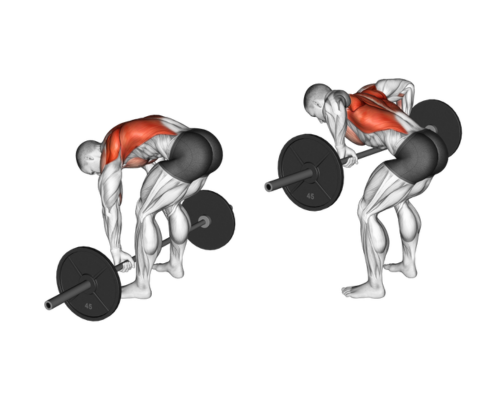
The Pendlay Row primarily targets the following muscles:
Primary Muscles
Latissimus Dorsi (Lats): The lats are the largest muscles in your back and play a vital role in pulling movements like the Pendlay Row. These muscles are responsible for adduction, extension, and internal rotation of the spine at the shoulder joint.
Trapezius (Traps): The traps are a large muscle group that runs along the spine and is responsible for scapular elevation, retraction, and depression. The Pendlay Row helps develop the middle and lower portions of the traps.
Rear Deltoids: The rear deltoids, located at the back of the shoulder, are involved in shoulder extension and provide shoulder stability during the rowing motion.
Secondary Muscles
In addition to targeting these primary muscles, the Pendlay Row also engages several secondary muscles, including:
Biceps: While the primary focus of the exercise is on the back muscles, the biceps play a supporting role in the pulling motion.
Lower Back: The lower back muscles, including the erector spinae, are activated to stabilize the spine and maintain proper posture throughout the movement.
Forearm Flexors: As you grip and hold the loaded barbell, during the Pendlay Row, the muscles in your forearms, specifically the flexors, contract to maintain your grip.
Rotator Cuff: The rotator cuff muscles, which include the infraspinatus, teres minor, supraspinatus, and subscapularis, help stabilize the shoulder joint during the rowing motion.
To perform the Pendlay Row effectively and target these muscles, proper form and technique are crucial. Focus on maintaining a strong and stable back position while executing the movement to maximize muscle recruitment and reduce the risk of injury.
How To Perform Pendlay Row
Here are the instructions for performing a Pendlay Row, a compound exercise that targets the upper back, shoulders, and arms:
Starting Position:
- Initiate with feet shoulder-width apart and position a barbell on the floor in front of you.
- Bend at your hips and knees to lower your torso until it is almost parallel to the floor.
- Grasp the barbell with an overhand grip.
Execution:
- Engage your core muscles and keep your back straight.
- Pull the barbell up towards your lower chest by driving your elbows straight back, and retracting your shoulder blades.
- Focus on squeezing your back muscles at the top of the movement.
Lowering Phase:
- Lower the barbell back to the starting position under control, fully extending your arms.
- Maintain proper form and avoid using momentum to lift the weight.
It is crucial to keep your chest up and your spine neutral with your back in a flat position throughout all your Pendlay row reps.
Sets And Reps
- For Strength: 3-5 sets of 4 to 8 reps with heavy weight.
- For Muscle Mass: 3-4 sets of 8 to 15 reps with middle-heavy weight.
- For Endurance: 3-4 sets of 15 to 20 reps with light weight.
Benefits of Pendlay Row
The Pendlay Row offers a full range of benefits for individuals looking to improve their strength, muscular development, and overall fitness level. Some key benefits of including the Pendlay Row in your workout routine include:
Strengthens Back Muscles
The Pendlay Row primarily targets muscles in the upper back, such as the traps, rhomboids, and lats, leading to increased strength and muscle development in that area.
Improves Posture
By strengthening the back muscles, the Pendlay Row helps to improve posture and spinal alignment, reducing the risk of postural imbalances and associated discomfort.
Enhances Grip Strength
Holding and lifting relatively heavy weight and weights during Pendlay Rows can help to improve grip strength, which is beneficial for various other exercises and daily activities.
Functional Movement
This exercise mimics pulling movements that are essential in daily activities and sports, improving overall functional and muscle-building, strength, and movement patterns.
Increases Upper Body Muscle Mass
The Pendlay Row is a compound exercise that targets multiple muscle groups in the upper body, helping to increase muscle mass and improve overall upper body strength.
Boosts Overall Fitness
Incorporating the benefits of the Pendlay Row into your workout routine can contribute to overall fitness and athleticism by targeting multiple muscle groups and promoting full-body strength.
Calorie Burn and Weight Management
Like any resistance training exercise, the Pendlay Row can help burn calories, increase metabolism, and support weight management goals when combined with a balanced diet and regular exercise regimen.
Overall, the Pendlay Row is a versatile exercise that can benefit individuals at various fitness levels, from beginners to advanced lifters, by targeting key muscle groups, improving strength and posture, and supporting overall fitness and health goals.
Top 6 Pendlay Row Alternatives
Pendlay rows are an advanced exercise for building a bigger and stronger back, which requires proper form and a strong back, and can be intimidating. Fortunately, there are plenty of other options for back strengthening. Here are our top 6 Pendlay Row alternatives.
- Rack Pulls: This exercise targets the upper back, lower back, and glutes, similar to the Pendlay Row but with the weight starting from an elevated position.
- Clean Pulls: An explosive Olympic lift that engages the back muscles while focusing on speed and power development.
- Inverted Row: A bodyweight exercise that targets the back muscles and can be modified based on difficulty level by adjusting the angle of the body.
- Deadlifts: A compound movement that targets multiple muscle groups, including the back, legs, and core, offering a comprehensive strength-building exercise.
- Banded Deadlifts: Utilizing resistance bands to increase the intensity of traditional deadlifts, providing a challenging variation.
- Inverted Bodyweight Rows: A bodyweight exercise that can be adjusted in difficulty based on the body’s position, targeting the back muscles effectively.
These alternative exercises offer a variety of options to strengthen the back muscles, improve overall upper body strength, and provide alternatives to the Pendlay Row. It’s essential to choose exercises that align with your goals, fitness level, and available equipment to ensure a safe and effective workout routine.
Pendlay Row Variations
Barbell Row

The traditional Pendlay Row variation involves using a barbell and maintaining a strict horizontal back position throughout the entire movement throughout. This variation primarily targets the back muscles, including the lats, traps, and rear deltoids.
Dumbbell Pendlay Row
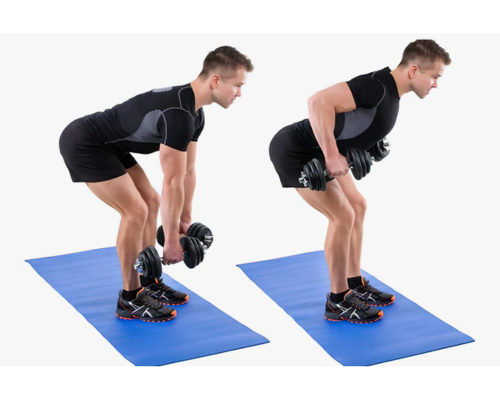
Instead of a traditional barbell row, you can perform the Pendlay Row with dumbbells. This variation allows for a greater range of motion and unilateral training, helping improve muscular balance and coordination.
Underhand Grip Pendlay Row
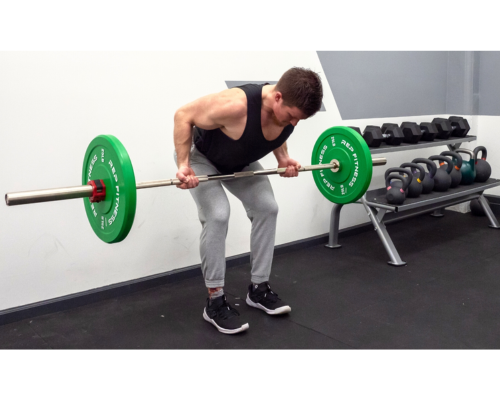
By using an underhand grip on the barbell, you can emphasize the biceps and lower traps more during the rowing motion. This variation can provide a different training stimulus to the muscles compared to the overhand grip.
Wide Grip Pendlay Row

Widening your grip on the barbell during the Pendlay Row can shift the focus onto the outer portion of the back, particularly targeting the lats and upper traps. This variation can help improve back width and overall muscle development.
Close Grip Pendlay Row
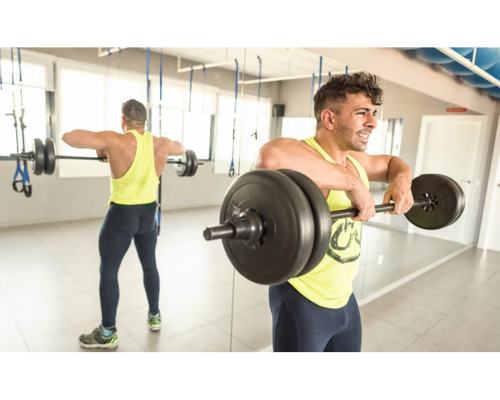
Conversely, using a closer grip on the barbell can target muscles in the inner portion of the back, including the rhomboids and middle traps. This variation can aid in improving back thickness and stability.
Paused Pendlay Row
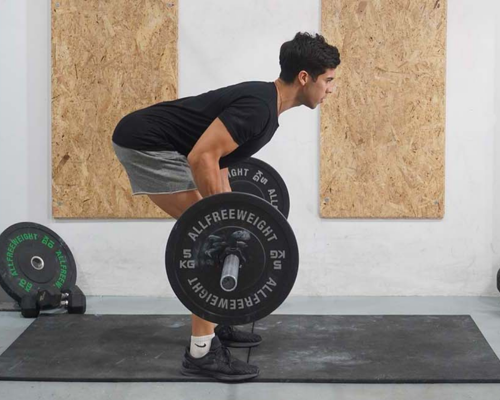
Adding a brief pause at the top or bottom of the rowing motion can increase time under tension and enhance muscle engagement. Pausing the movement allows muscles time for better control and contraction of the targeted muscles.
Deficit Pendlay Row

A deficit Pendlay Row is a variation of the traditional Pendlay Row exercise performed on an elevated surface. It increases the range of motion and targets the back muscles. Follow the same steps as a regular Pendlay Row but stand on an elevated surface before grabbing the barbell.
Performing Pendlay Rows on a deficit increases the range of motion and places a greater emphasis on the muscles of the back, particularly the latissimus dorsi, traps, and rear deltoids. It can help to enhance strength, muscular development, and overall back definition.
Common Pendlay Row Mistakes
Common mistakes to avoid while performing Pendlay Rows include:
Incorrect Form: One of the most common mistakes is rounding the back during the movement. It’s essential to maintain a flat back throughout the exercise to prevent injury and effectively target the back muscles.
Using Too Much Weight: Using too much weight or weights that are too heavy can compromise your form and increase the risk of injury. Start with a moderate weight that allows you to perform the exercise with proper technique.
Incomplete Range of Motion: Failing to lift the barbell to the torso or not fully extending the arms at the bottom of the movement can reduce the effectiveness of the exercise. Ensure you are lifting more weight with the barbell towards the lower chest and fully extending the arms at the bottom position.
Jerking or Swinging the Weight: Avoid using momentum to lift the weight, as this takes the focus away from the back muscles and can strain other body parts such as the lower back. Focus on controlled movements and avoid swinging the weight.
By avoiding these common mistakes and ensuring proper form and technique, you can perform Pendlay Rows safely and effectively to target the back muscles and achieve your fitness goals.
Other Resources
For more back exercises, check out these articles
Conclusion
Pendlay Rows are a versatile exercise that can benefit individuals at various fitness levels. By incorporating proper form, adjusting weights according to goals, and avoiding common mistakes, you are sure to effectively target the back muscles and work towards achieving your fitness goals!
What is the Pendlay row good for?
Why are Pendlay rows hard?
Is Pendlay row explosive?
Should you go heavy on Pendlay row?
Mike Dewar. (2023). How to Do the Pendlay Row for Back Size and Stronger Lifts. Available at: https://barbend.com/pendlay-row/ [Accessed 26 Mar 2024].
Steve Hoyles. (2023). How to Pendlay Row: Everything You Need to Know. Available at: https://central.gymshark.com/article/how-to-pendlay-row-everything-you-need-to-know [Accessed 26 Mar 2024].





